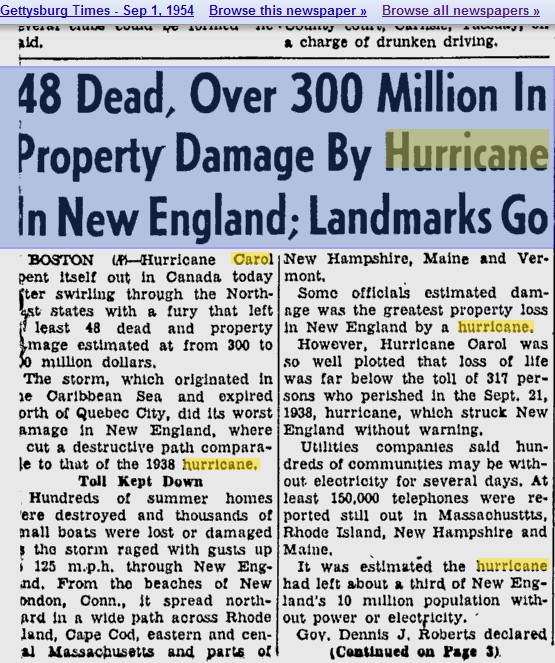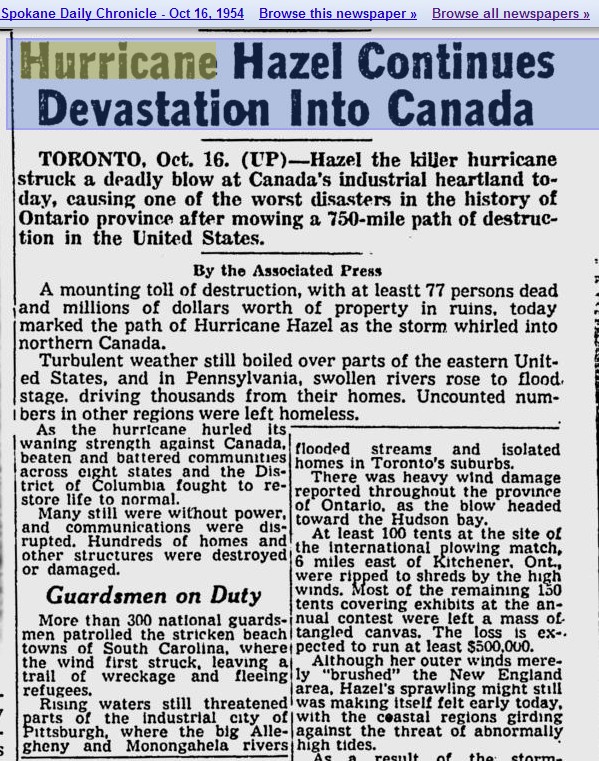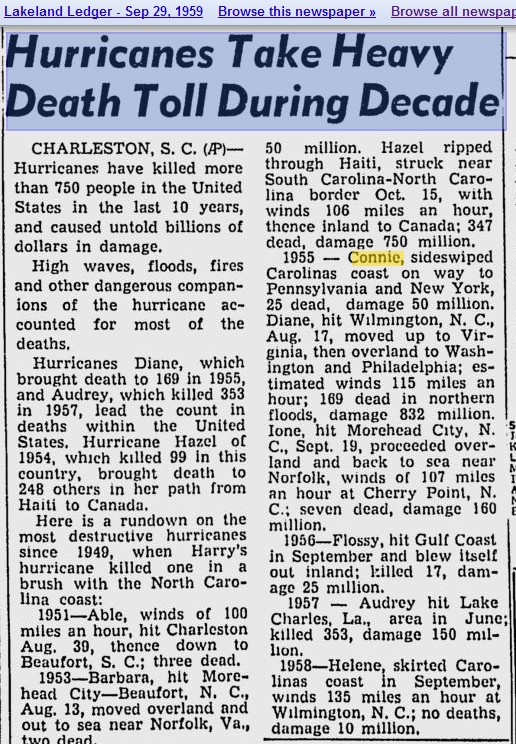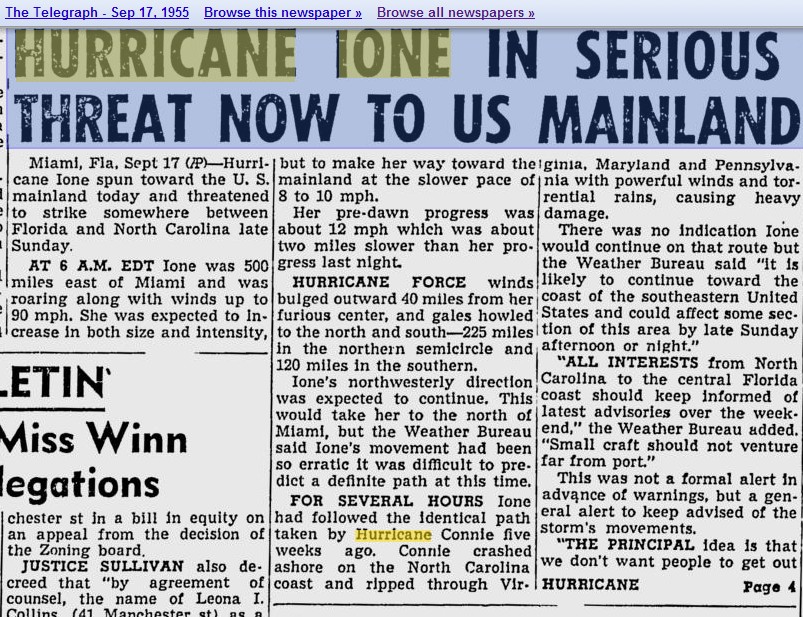It has been almost eight years since a major hurricane struck the US, the longest such period since the Civil War.
But from August 1954 through September 1955, five major hurricanes struck the US – Carol, Edna, Hazel, Connie and Ione
Gettysburg Times – Google News Archive Search
The Deseret News – Google News Archive Search
Spokane Daily Chronicle – Google News Archive Search
Lakeland Ledger – Google News Archive Search
Despite the fact that Obama has had possibly the quietest spell of hurricanes of any president, his teleprompter still tells the American people that hurricanes are getting worse.







In 1975 so-called climate experts blamed tornadoes on global cooling.
http://dailycaller.com/2013/05/21/newsweek-in-1975-tornado-outbreak-blamed-on-global-cooling/
Someone needs to talk some sense into that teleprompter.
These fine hurricanes didn’t have the post-modern marketing available for Sandy. That’s “Superstorm” Sandy.
Too many private jets flowing into Cannes. The real question is “Does the Cannes film festival” cause the tornadoes.
Best track database has only Hazel striking the east coast as a Cat 3 or higher. Carol’s peak winds anywhere along its track were 85kts (100 mph – Cat 2). Edna was a borderline Cat 1/2 when it struck eastern MA. Connie struck NC as a Cat 1, Ione as a low-end Cat 2. True, these were all major impacts, and I certainly lie strongly in your camp with respect to this AGW hoax. CO2 is not a factor. There were many strong hurricanes striking the coast in the past. In fact, there’s no significant trend in major hurricane impacts over the last 100 years except for possibly a slight downward trend.
NOAA lists them as major US hurricane strikes
Of course they were major impacts, like Sandy and Isaac last year (both Cat 1s), but except for Hazel, they struck land as Cat 1 or 2 hurricanes. The best track database and even the graphics on the NHC’s website contradict NOAA’s text. How could Carol have struck Long Island as as Cat 3 if it never reached Cat 3 strength anywhere along its track?
http://www.nhc.noaa.gov/outreach/history/#connie
Best Track database:
ftp://rammftp.cira.colostate.edu/demaria/ebtrk/ebtrk1851to1987climoradii.txt
I actually don’t work for NOAA.
the entirety of the current best track data can largely be ignored, best place to go is HURDAT as there is an ongoing reanalysis, and several hurricanes that were initially thought to be of lower intensity were stronger, including Connie and Edna, both upgraded to Cat 3 (I can’t speak for 1955 as it is not yet complete.)
http://www.aoml.noaa.gov/hrd/hurdat/10_US_hurricanes.pdf
http://www.aoml.noaa.gov/hrd/data_sub/re_anal.html
Carol:
8/31/1430Z 40.9N 72.2W landfall in NY
100 kt/955 mb, RMW 22 nmi, NY3 impact
8/31/1515Z 41.3N 72.0W landfall in CT
100 kt/957 mb, RMW 22 nmi, CT2, RI3, MA2 impacts
Edna:
11th/18Z – 41.3N 70.7W – 948 mb/105 kt – 20 nmi RMW
11th/19Z – 41.6N 70.5W – 950 mb/100 kt – 20 nmi RMW
100kts = 115mph = Cat 3
Chris H.,
The document you reference lists windspeed in knots, not mph. So multiply by about 1.15 to get mph
Chris, Your own link states that Connie hit NC as a cat 3
“An erratic, generally north-northwestward motion then brought Connie to the North Carolina coast on August 12 as a Category 3 hurricane”
http://www.nhc.noaa.gov/outreach/history/#connie
Carol was Cat3 landfall in NY, RI, and CT. First retired name in hurricane history.
http://www.aoml.noaa.gov/hrd/hurdat/ushurrlist.htm
http://en.wikipedia.org/wiki/Hurricane_Carol
As a hurricane forecaster for the past 30+ years I do know the difference between knots and mph. The best track database still lists Carol as peaking at Cat 2 with 85 kt (98 mph) winds. I would trust the best track database over a post in Wikipedia.
As for Connie, the best track database clearly has Connie as a Cat 1/2 hurricane at landfall in NC. Even the graphics on the NOAA page that say Connie hit as a Cat 3 do not show it as a major hurricane at landfall:
http://www.nhc.noaa.gov/outreach/history/connie_1955_map.gif
There are clearly quite a few errors on the NOAA website and likely in Wikipedia. The only one of the 5 storms listed that appears to have hit as a Cat 3 or greater was Hazel.
I suggest you take it up with NOAA. I normally NOAA and NASA data sets as my starting point for any discussion of data.
Chris H.,
There are clearly quite a few errors in HURDAT, There is no single flawless source of data. There is bias in the reanalysis algorithms. These biases lower wind speeds from the 1940s through the 1960s, and increase speeds of recent hurricanes.
http://www.aoml.noaa.gov/hrd/hurdat/1944-53-reanalysis.pdf
Chris H,
If Carol was a Cat 1 as you suggest, then we have a great miracle on our hands. 75mph winds were able to heel an entire US aircraft carrier (Nahenta Bay).
Compare the visual photographic evidence and written historical record to the reanalysis project. Don’t be so convinced by ASCII text.